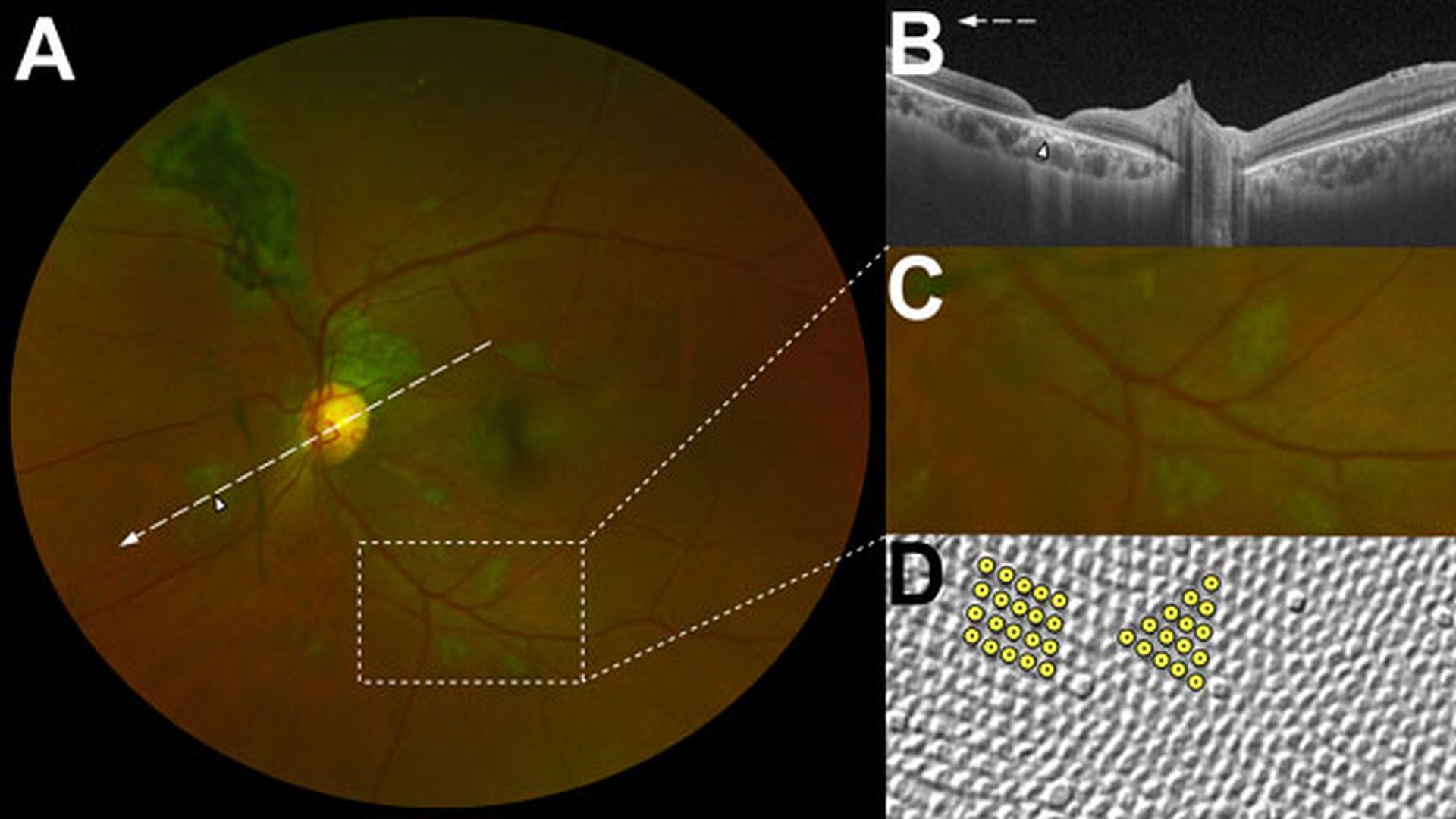Researchers Discover Unique Retinal Scar Specific to Ebola Virus Disease


Characteristic features of lesions observed in a case–control study of ocular signs in Ebola virus disease survivors, Sierra Leone, 2016. A) Composite scanning laser ophthalmoscope retinal image, left eye. Arrow indicates direction of the optical coherence tomography scan. B) Optical coherence tomography. White, long, dashed line indicates cross-sectional plane; white arrowhead indicates Ebola lesion limited to the retinal layers with an intact retinal pigment epithelium. Magnified 1.5× from original image (panel A). C) Examples of straight-edged, sharp angulated lesions (magnified from panel A). D) Example of tangential section through the human fovea with illustrative highlighting of a triangular photoreceptor matrix corresponding to Ebola lesional shape. Courtesy of Ahnelt et al.
In West Africa, the largest outbreak of Ebola virus disease in history left just over 10,000 survivors; previous outbreaks left only dozens. The scale of this epidemic and its large number of survivors has facilitated research on the after-effects of Ebola (post-Ebola syndrome). It is known that the Ebola virus is capable of persisting in the eye even after recovery from the acute infection often causing severe inflammation and even cataracts in some survivors. However, little has been known about specific effects of the virus on the back of the eye and if cataract surgery is safe for survivors and surgeons.
In a recent study by Steptoe, et al. (2017) of the long-term effects of the Ebola virus on the eye, researchers working with Ebola survivors in Sierra Leone discovered a unique retinal scar specific to the disease. The location of the scars suggests that the virus can travel along the optic nerve to reach the eye. Fortunately, the scars appear to spare the central vision. Researchers also tested the eye fluid of two survivors with cataracts secondary to Ebola and found the virus had cleared from the eye fluid; this provides provisional evidence that cataract surgery can be attempted safely.
Reference: Steptoe PJ et al. Novel Retinal Lesion in Ebola Survivors, Sierra Leone, 2016. Emerging Infectious Diseases, Vol. 23, No. 7, July 2017.
The Key to Sterile Processing Success: Leadership Engagement and Team Collaboration
January 24th 2025Effective sterile processing leadership requires active engagement, clear communication, and a transformational approach to foster collaboration, accountability, and quality in infection prevention and surgical instrument management.
Evaluating Automated Dispensing Systems for Disinfectants in Hospitals
January 23rd 2025Hospitals rely on automated disinfectant dispensers, but a study led by Curtis Donskey, MD, found inconsistent dilution levels, with some dispensers releasing only water. Improved monitoring and design modifications are essential.
Alcohol-Based Antiseptics Show Promise for Nasal Decolonization and SSI Prevention
January 23rd 2025A meta-analysis found alcohol-based antiseptics significantly reduce Staphylococcus aureus-related surgical site infections (SSIs), demonstrating efficacy comparable to mupirocin and iodophor, supporting their expanded use in infection prevention strategies.
ASRA Pain Medicine Releases Groundbreaking Infection Control Guidelines for Pain Management
January 22nd 2025The American Society of Regional Anesthesia and Pain Medicine (ASRA Pain Medicine) released comprehensive infection control guidelines for pain procedures, emphasizing prevention, early recognition, multidisciplinary collaboration, and judicious antibiotic use to enhance patient safety and healthcare outcomes.